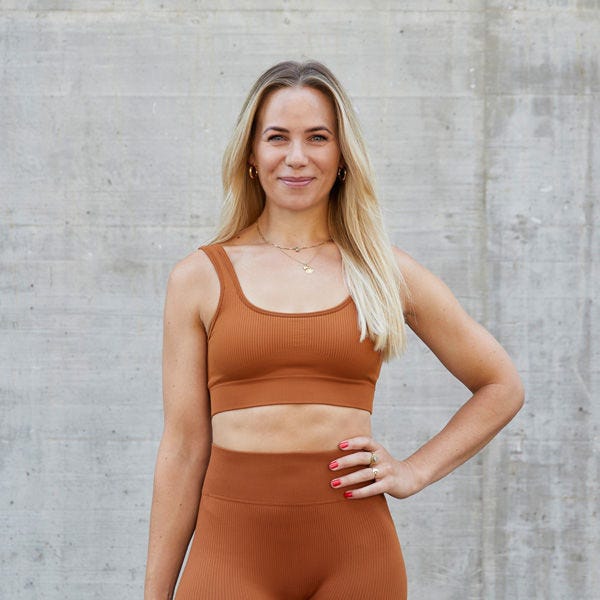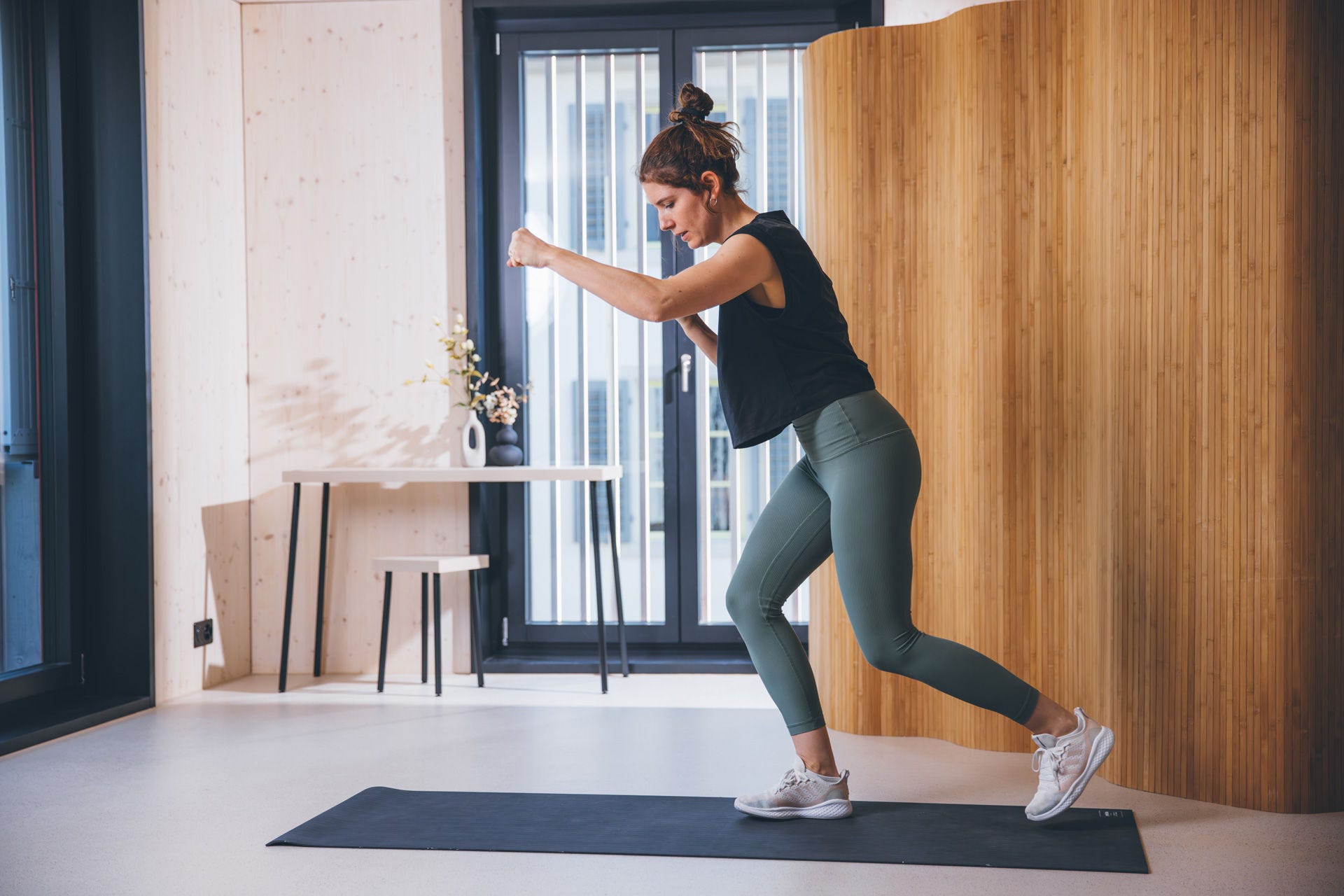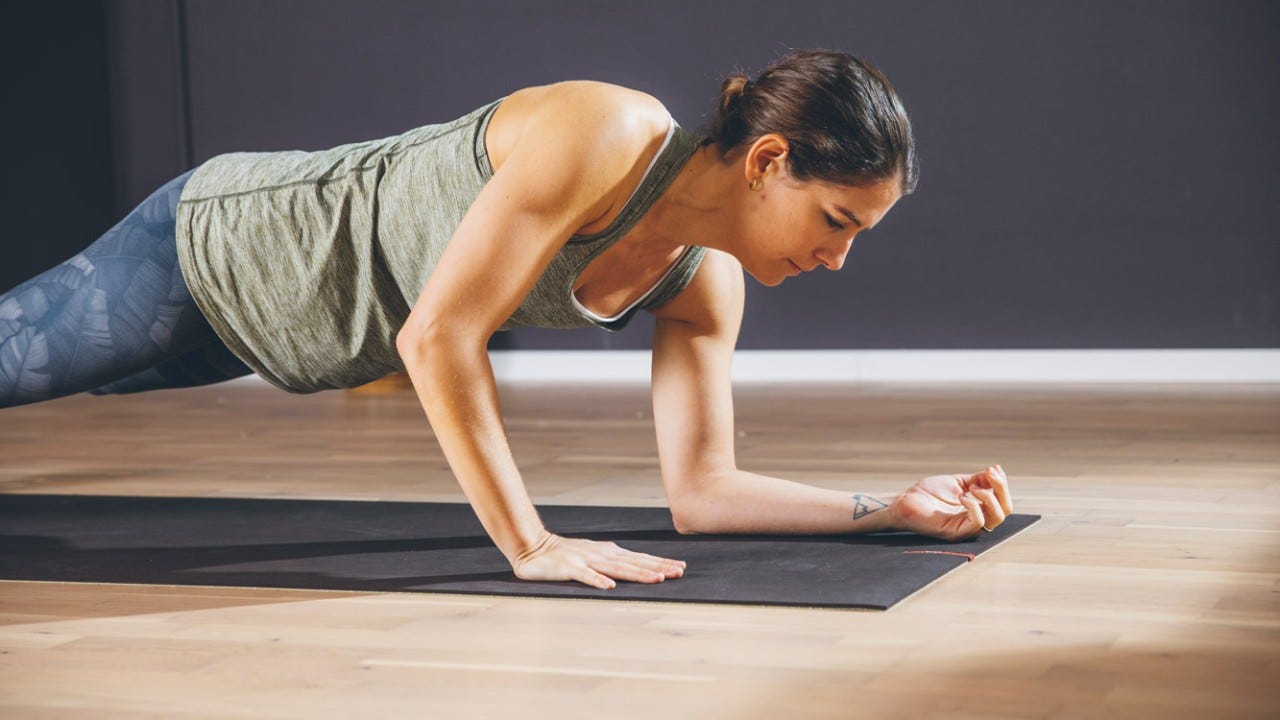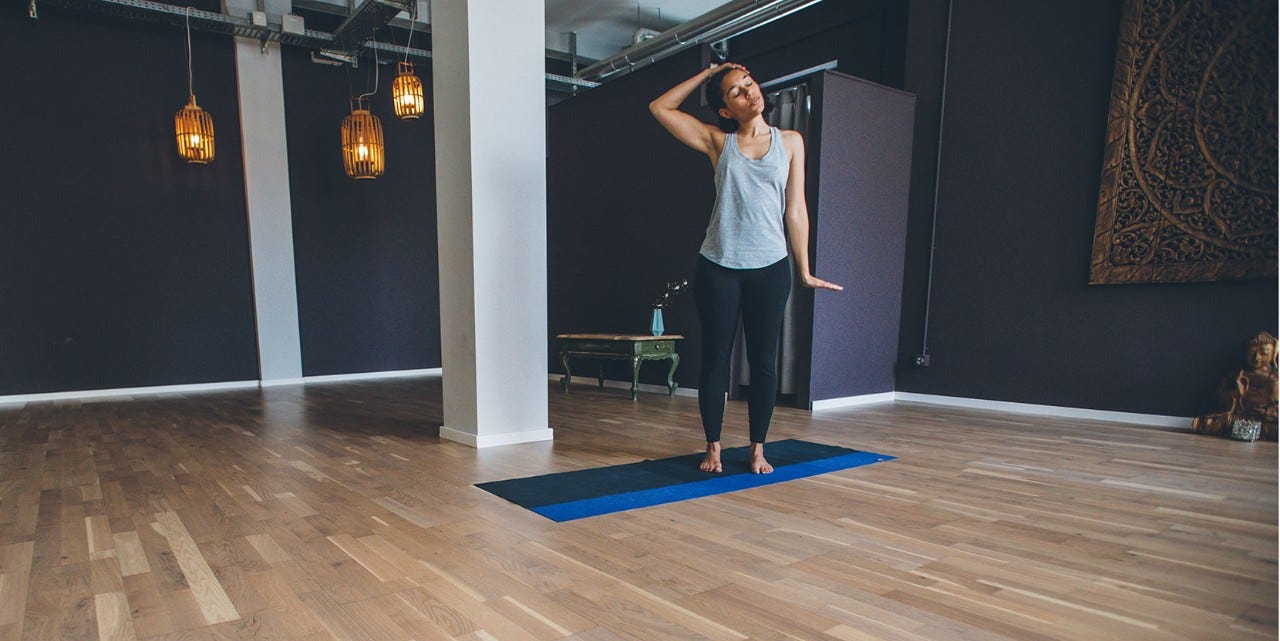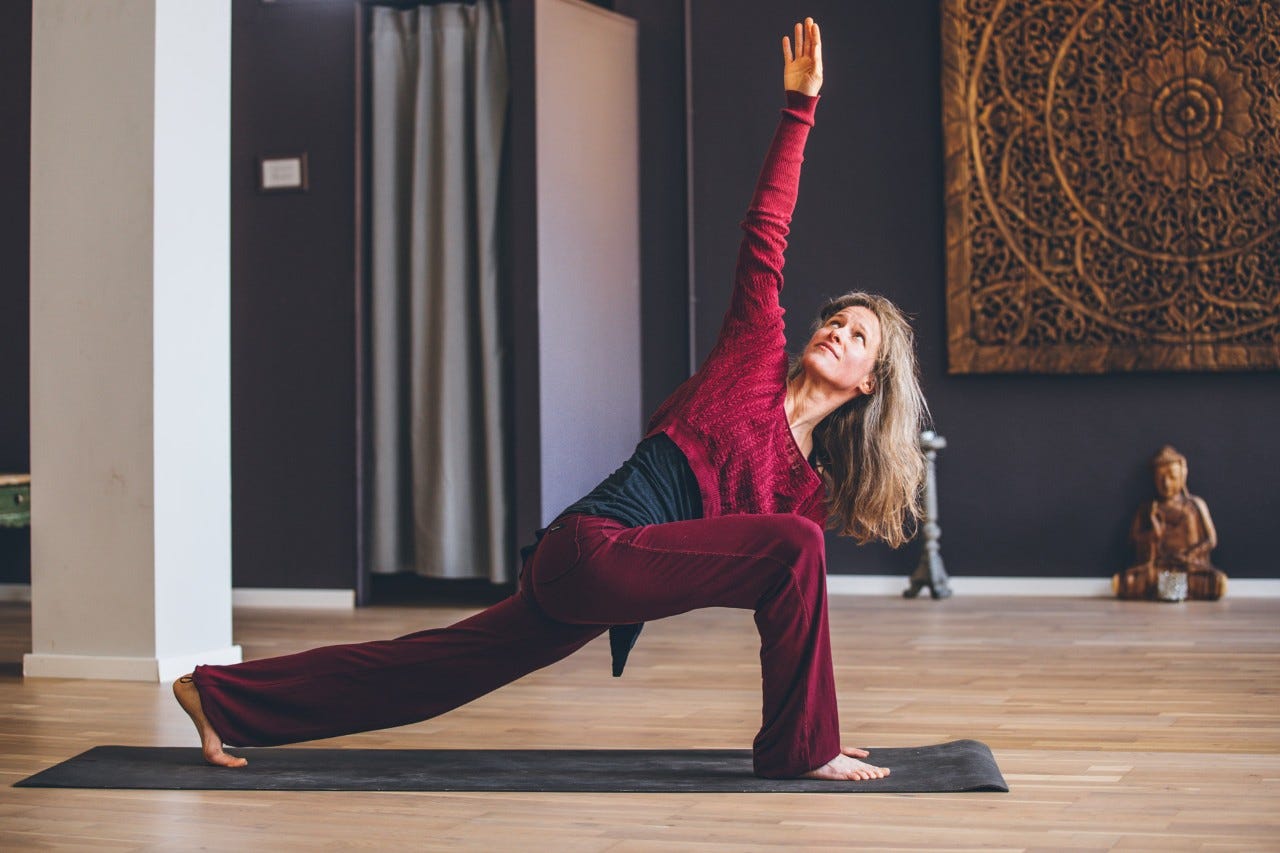Leg workout: Four exercises you can do at home
Strong legs carry us through life more easily. Discover everything you need to know for an effective leg workout – and get started today.
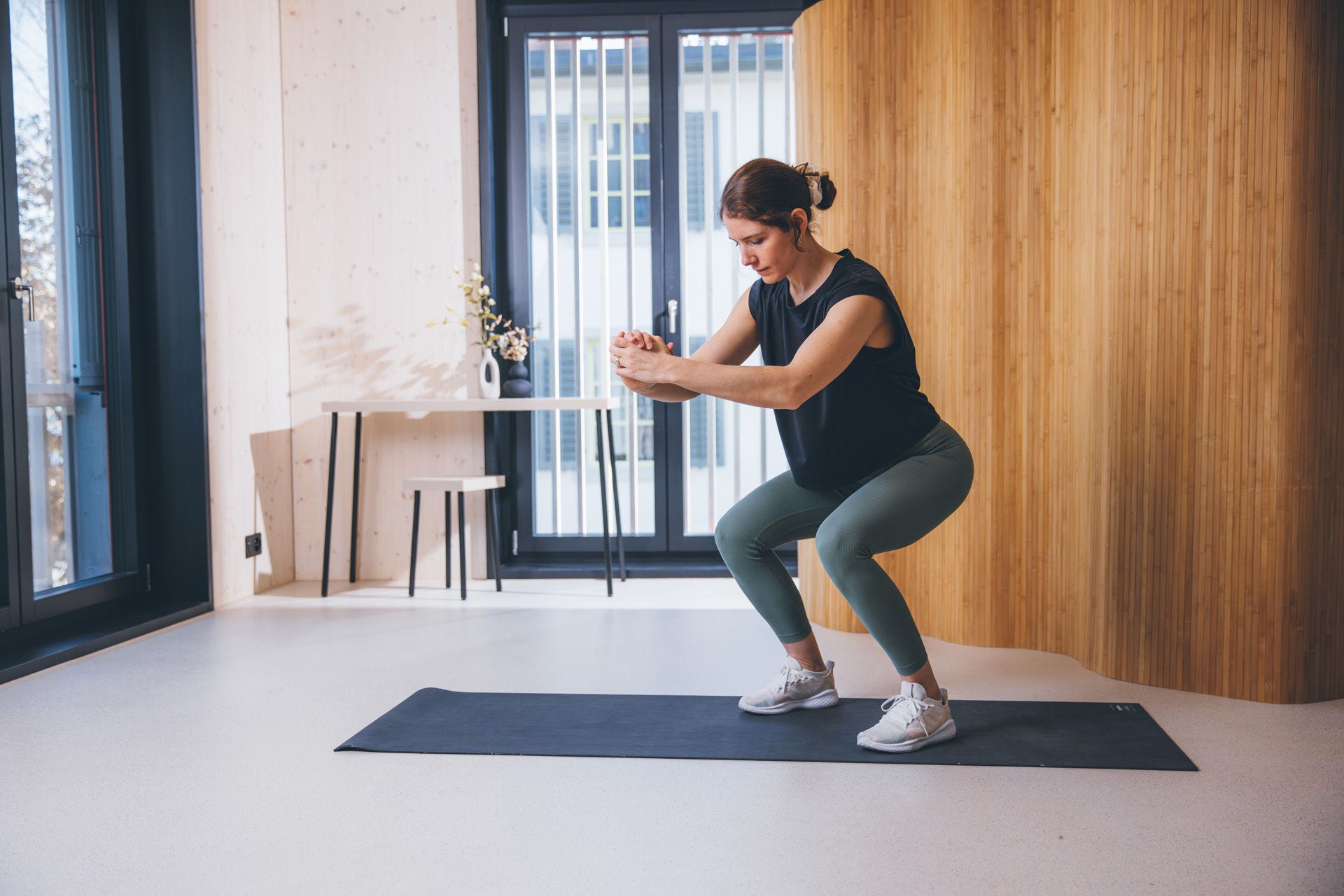
Video: Four effective leg exercises in 15 minutes
Why is it important to train your legs?
Our legs contain the largest muscle groups in the body. “They give us a steady gait, jumping power and balance,” says Nadine Michel. The personal trainer from Zurich works with people of all ages.
Without strength in the legs, the core and upper body are powerless. The core can only work efficiently when it rests on a stable foundation.
In general, muscle strength and mass decrease with age. “Anyone who does nothing to counteract muscle loss will see both start to decline slowly from around the age of 30. This loss accelerates from the age of 50,” says Michel. “The earlier you start training, the better.”
Four benefits of leg training
- Leg strength helps us perform life’s natural movements more easily – and, especially as we get older, more safely.
- Our legs are our means of movement: strong legs help us move through life with ease and without pain.
- Strong legs also enhance our balance and stability.
- As we get older, strong legs protect us from falls and fractures – such as a fracture of the femoral neck.
How often should you do leg exercises?
As with any form of physical activity consistency and gradual progression are the key to success in leg training.
Pay attention to these factors when working out at home or in the gym:
-
Training at home
If you exercise at home, you should train 2-3 times per week. Three sessions are often easy to achieve as you don’t need to leave the house – one of the advantages of home workouts.
For home training, personal trainer Nadine Michel generally recommends a full-body workout that includes the legs.
“It’s important not to train the legs in isolation – but also the core and upper body,” says Michel. If the core lacks strength, it’s difficult to train the legs properly without putting strain on the lower back.
Two options for your training plan:
Option 1: On the first day, train the lower body, on the second day the upper body – and on the third day the lower body again. In the following week, reverse the order: upper body, lower body, upper body.Option 2: Or do a full-body workout three times a week.
For both options, you can do up to 25 repetitions per exercise if you are training without equipment.
Extra boost for home:
If you want to make your workout more challenging, you can add dumbbells for home use, wear a rucksack filled with books, use kettlebells or simply hold filled water bottles.
-
Strength training in the gym
This depends entirely on your goal for your legs: Do you want to keep them healthy and fit, shape them visibly or build muscle on a larger scale?
For fit legs: Train two times a week. Work the large muscles with squats, deadlifts or hip thrusts (see below) – with 3-4 sets of 10-12 repetitions. For smaller muscles, such as the calves, two sets of 12-15 repetitions are sufficient.
For visibly shaped legs: You should go to the gym 3-5 times a week. Include leg training in at least 2-3 of those sessions. Work the large muscles with squats, deadlifts or hip thrusts (see below) – with 3-4 sets of 10-12 repetitions. For smaller muscles, such as the calves, two sets of 12-15 repetitions are sufficient.
For maximum muscle strength: You should also go to the gym 3-5 times a week. Include leg training in at least 2-3 of those sessions. Train the large muscles here with significantly fewer repetitions but with more weight. For this type of training, you should consult a personal trainer.
Seven leg exercises without equipment
If you want strong legs, you can start today with the right training at home.
There are the most important leg exercises – targeting all the muscles in the legs, glutes and core – that should be part of every successful leg workout:
-
Squats
- Stand with your feet hip-width apart.
- Your toes should point slightly outwards in a V-shape.
- As you inhale, activate your core by pulling your navel inwards. Bend your knees, lowering your glutes towards your heels – as if sitting down on a low chair.
- As you exhale, push through your heels into the floor – as if driving your glutes back up from the ground.
- Throughout the entire exercise: Keep your core engaged and your back as neutral as possible.
- You can cross your hands in front of your chest or place them on your hips.
- Without resistance or equipment, you can do up to 15 repetitions. If you can manage more than 20 repetitions, you can use additional weights. In that case, 8-12 repetitions are sufficient.
Tips for beginners
Use a chair or your sofa for support. Perform the exercise so that you have a surface to hold onto if your leg strength fades during the movement.
If you find breathing in and out difficult, simply breathe continuously – regardless of which part of the exercise you are performing.
-
Lunges
- Stand with your feet hip-width apart.
- Place your hands on your hips.
- Engage your core by pulling your navel inwards.
- As you inhale, step forward with your right foot – bend both knees, ideally to 90 degrees.
- As you exhale, push off from the front foot to return to the starting position, feet hip-width apart in one line, with your legs straight.
- Next, do the same with your left foot – step forward and back.
- Alternate between both sides. Do 10-12 repetitions per side.
Tips for beginners
Practise near an object such as a wall, sofa or chair – somewhere you can hold on if needed.
-
Bridge
- Lie on your back on the floor.
- Bend your knees until your ankles are directly under them.
- Your feet should be hip-width apart on the mat.
- As you inhale, press your feet into the floor and lift your glutes, pelvis, lower and upper back. Keep your knees and thighs parallel to prevent them from opening out to the sides.
- As you exhale, slowly lower your back, pelvis and glutes back to the floor.
- You can do 20-25 repetitions – until you feel a burn in your glutes.
-
Hip thrust
For this more intensive variation, you will need a stable surface about knee height (e.g. a chair, firm bed, sofa or sideboard).
- Sit on the floor in front of your surface.
- Bend your knees and place your heels where your knees were when your legs were extended.
- Cross your hands in front of your chest.
- Sit upright, close to your support surface.
- As you inhale, press your feet into the floor and lift your pelvis until your shoulder blades and shoulders rest on the surface.
- As you exhale, lower your glutes back towards the floor, finishing the repetition seated in front of the surface.
- Do 15-20 repetitions.
-
Single-leg deadlifts
- Stand with your feet hip-width apart.
- As you inhale, lower your arms towards the floor while raising your right leg backwards. Imagine you are about to tie the shoelace of your straight left leg. Push your hips back as you do so.
- As you exhale, return to an upright position and lower your right foot back to the floor.
- Now switch sides: lift your left leg backwards while lowering your upper body towards your foot, standing on your straight right leg.
- Do 8-10 repetitions per side. If this feels too easy: Increase the number of repetitions or add weight for assistance.
-
Step-ups
- Choose a location with a step (e.g. stairs, stepper, bench, low wall).
- Stand with your feet hip-width apart. Your toes should point forward.
- Inhale and engage your core.
- Exhale and step up with your right foot, followed by your left foot.
- Inhale at the top.
- Exhale and step down with your right foot first, then your left foot.
- Do 10 repetitions per side.
Tips for beginners
Make sure your knees don’t fall inwards or outwards when stepping up and down. Your toes and knees should always point forward. If you have difficulty balancing, you can hold onto something at the side for support.
It’s also important to step down from the raised surface in a controlled manner – don’t let yourself “drop” down.
-
Bulgarian split squats
For this slightly more challenging exercise, you will need a surface about the height of a bench (roughly knee height).
- Stand one leg’s length in front of your bench, with your back facing it.
- Place your left foot behind you on the bench, with the top of your foot resting gently on the surface.
- As you inhale, bend your front knee to 90 degrees; your back knee also bends and moves towards the floor.
- As you exhale, press your front foot into the floor, engage your glutes and push yourself back up. The front leg should be straight.
- Do 10-12 repetitions on one side, then the same number on the other.
- This exercise is intense and requires good balance. If you are doing it for the first time: Make sure you have something to hold on to in case you lose your balance.
Warming up properly and stretching after exercise
A proper workout also includes a warm-up phase and stretching after exercise.
-
Before training: warming up
Starting straight away with intense exercises risks muscle strains and other injuries. That’s why you should always take time before each workout to warm up and activate your body.
Various mobility exercises are suitable for this – activating the spine, opening the thoracic vertebrae and engaging the core. In the gym, a few minutes of warm-up on the bike or cross-trainer are ideal.
-
After training: stretching
If you want strong, well-defined legs, you should also remember to stretch after your workout.
Personal trainer Nadine Michel recommends stretching the following day – that is, one day after your workout.
“After training, the muscle fibres are slightly damaged – the strain causes tiny tears, which is normal and important for muscle growth. If you stretch intensively straight afterwards, it can worsen the tears, delay recovery, irritate the tissue and, in the worst case, cause overuse injuries,” says Michel.
That’s why – whether after a home workout or a gym session – it’s better to cool down gently, do some mobility exercises or stretch very lightly immediately after training.
You can stretch more intensively a day after training and on rest days, once the muscle has had some time to recover.
Common mistakes and tips for leg training
A healthy dose of motivation and enthusiasm is important to start leg training – and, above all, to continue it successfully.
That said, it is possible to overdo it. Here are the most common mistakes to avoid when training at home – and tips on how you should approach things instead:
- Wanting too much too soon: Whether at home or using weights in the gym, start slowly and build your training gradually. If you begin too ambitiously, lift too much weight or do exercises that are too intense, you risk injury and may not be able to continue training.
- Neglecting technique: Pay attention to your form. Performing exercises poorly – or worse, incorrectly – increases the risk of injury, joint wear and poor posture. Also, watch your overall posture. A mirror can help you become more aware of your movements.
- Training without a plan: If you train without structure, you will almost certainly miss your goal. First, ask yourself: what is my goal? And what plan will help me to achieve it? Personal trainers can provide valuable support with this.
- Too few breaks: Training without rest is unhealthy for the body. It needs time to recover between sessions. Only in this way can you train healthily and successfully in the long term. Also, listen to your body – especially if you are in pain. Ignoring warning signs also increases the risk of injury and of developing chronic problems
- Only doing your favourite exercises: Don’t always train in the same way. One-sided training leads to imbalances in the body. Add variety to your workout plan – muscles respond well to different types of stimulus.
- No progression: If you do the same training for weeks, your body will lack the progression it needs for muscles, tendons and ligaments to be trained optimally and to improve their performance.
That’s why you should gradually increase the intensity of your training – this might mean adding more weight (in strength training), but not only that: refine your technique and slow down the movements. This gives the body – and the muscles – new stimuli.
